Effects of the Parameter C4ε in the Extended k-ε Turbulence Model for Wind Farm Wake Simulation Using an Actuator Disc
Abstract
:1. Introduction
2. Numerical Simulation of Wind Farm Wakes
2.1. RANS-Based Flow Governing Equations and Turbulence Model
2.2. ADM in PHOENICS
2.3. Computational Domain and Boundary Conditions Settings
2.4. Grid Refinement Study
3. Test Cases
3.1. Horns Rev Offshore Wind Farm Case
3.2. Nysted Offshore Wind Farm Case
3.3. Wieringermeer Onshore Wind Farm Case
3.4. Effects of Parameter C4ε on Wind Farm Wake Simulation Considering Six Test Cases
4. Results and Discussion
4.1. Horns Rev Offshore Wind Farm
4.2. Nysted Offshore Wind Farm
4.3. Wieringermeer Onshore Wind Farm
5. Conclusions
- (1)
- The decreased parameter C4ε makes the generation scope of TKE in the vicinity of the turbine smaller, but the TKE near the rotor becomes larger, and the wake recovery rate of the downstream turbine is less affected by the near wake. As the interwind turbine spacing increases, the influence area of TKE in the wake region of each downstream machine gradually reduces, and atmospheric turbulence plays a dominant role in wake recovery.
- (2)
- The decrease in parameter C4ε can efficiently promote the increase in TKE in the vicinity of each downwind rotor and facilitate the rise of inflow wind speed and power generation. The final stabilization of the power output is attributed to the dominant role of ambient turbulence in the atmosphere, and the mixing of wake turbulence with ambient turbulence is no longer intense. In addition, the increase in the ambient undisturbed inflow wind velocity can promote the further improvement of TKE, inflow wind speed, and power generation at the hub height of downstream-located rotors. Furthermore, an increase in TKE at the hub height of downwind rotors thereby causes inflow wind speed reduction, and the power deficits increase when the ambient undisturbed inflow wind speed passes through a larger-scale wind turbine.
- (3)
- The coupling numerical model in this paper is validated by six sets of measured power data from three wind farms. It has been found that when the parameter C4ε equals 0.15, the simulated power results are compared well with the measured power outputs. The proposed coupling numerical model and the further calibration of the parameter C4ε can provide essential technical support for micro-siting, operation control, and power output prediction on wind farms.
Author Contributions
Funding
Institutional Review Board Statement
Informed Consent Statement
Data Availability Statement
Conflicts of Interest
References
- Archer, C.L.; Vasel-Be-Hagh, A.; Yan, C.; Wu, S.; Pan, Y.; Brodie, J.F.; Maguire, A.E. Review and evaluation of wake loss models for wind energy applications. Appl. Energy 2018, 226, 1187–1207. [Google Scholar] [CrossRef]
- Tian, J.; Zhou, D.; Su, C.; Soltani, M.; Chen, Z.; Blaabjerg, F. Wind turbine power curve design for optimal power generation in wind farms considering wake effect. Energies 2017, 10, 395. [Google Scholar] [CrossRef] [Green Version]
- Herbert-Acero, J.F.; Probst, O.; Réthoré, P.E.; Larsen, G.C.; Castillo-Villar, K.K. A review of methodological approaches for the design and optimization of wind farms. Energies 2014, 7, 6930–7016. [Google Scholar] [CrossRef]
- Mohammadi, B.; Pironneau, O. Analysis of the K-Epsilon Turbulence Model; MASSON: Paris, France, 1993. [Google Scholar]
- Van Der Laan, M.P.; Sørensen, N.N.; Réthoré, P.E.; Mann, J.; Kelly, M.C.; Troldborg, N.; Machefaux, E. An improved k-ϵ model applied to a wind turbine wake in atmospheric turbulence. Wind Energy 2015, 18, 889–907. [Google Scholar] [CrossRef] [Green Version]
- Chu, C.R.; Chiang, P.H. Turbulence effects on the wake flow and power production of a horizontal-axis wind turbine. J. Wind Eng. Ind. Aerodyn. 2014, 124, 82–89. [Google Scholar] [CrossRef]
- Naderi, S.; Parvanehmasiha, S.; Torabi, F. Modeling of horizontal axis wind turbine wakes in Horns Rev offshore wind farm using an improved actuator disc model coupled with computational fluid dynamic. Energy Convers. Manag. 2018, 171, 953–968. [Google Scholar] [CrossRef]
- Gao, X.; Yang, H.; Lu, L. Optimization of wind turbine layout position in a wind farm using a newly-developed two-dimensional wake model. Appl. Energy 2016, 174, 192–200. [Google Scholar] [CrossRef]
- Qian, G.-W.; Ishihara, T. Wind farm power maximization through wake steering with a new multiple wake model for prediction of turbulence intensity. Energy 2021, 220, 119680. [Google Scholar] [CrossRef]
- Sørensen, J.N.; Shen, W.Z. Numerical modeling of wind turbine wakes. J. Fluids Eng. 2002, 124, 393–399. [Google Scholar] [CrossRef]
- Martínez-Tossas, L.A.; Churchfield, M.J.; Leonardi, S. Large eddy simulations of the flow past wind turbines: Actuator line and disk modeling. Wind Energy 2015, 18, 1047–1060. [Google Scholar] [CrossRef]
- Stevens, R.J.A.M.; Martínez-Tossas, L.A.; Meneveau, C. Comparison of wind farm large eddy simulations using actuator disk and actuator line models with wind tunnel experiments. Renew. Energy 2018, 116, 470–478. [Google Scholar] [CrossRef]
- Kuo, J.Y.; Romero, D.; Beck, J.C.; Amon, C.H. Wind farm layout optimization on complex terrains–Integrating a CFD wake model with mixed-integer programming. Appl. Energy 2016, 178, 404–414. [Google Scholar] [CrossRef]
- Cruz, L.E.B.; Carmo, B.S. Wind farm layout optimization based on CFD simulations. J. Braz. Soc. Mech. Sci. Eng. 2020, 42, 433. [Google Scholar] [CrossRef]
- Van der Laan, M.P.; Sørensen, N.N.; Réthoré, P.E.; Mann, J.; Kelly, M.C.; Troldborg, N.; Murcia, J.P. The k-ϵ-fP model applied to wind farms. Wind Energy 2015, 18, 2065–2084. [Google Scholar] [CrossRef] [Green Version]
- Simisiroglou, N.; Polatidis, H.; Ivanell, S. Wind farm power production assessment: Introduction of a new actuator disc method and comparison with existing models in the context of a case study. Appl. Sci. 2019, 9, 431. [Google Scholar] [CrossRef] [Green Version]
- Ali, B.; Darbandi, M. An improved actuator disc model for the numerical prediction of the far-wake region of a horizontal axis wind turbine and its performance. Energy Convers. Manag. 2019, 185, 482–495. [Google Scholar]
- El Kasmi, A.; Masson, C. An extended k-ε model for turbulent flow through horizontal-axis wind turbines. J. Wind Eng. Ind. Aerodyn. 2008, 96, 103–122. [Google Scholar] [CrossRef]
- Tian, L.L.; Zhu, W.J.; Shen, W.Z.; Sørensen, J.N.; Zhao, N. Investigation of modified AD/RANS models for wind turbine wake predictions in large wind farm. In Journal of Physics: Conference Series; IOP Publishing: Bristol, UK, 2014; Volume 524, p. 012151. [Google Scholar]
- Xu, C.; Han, X.; Wang, X.; Liu, D.; Zheng, Y.; Shen, W.Z.; Zhang, M. Study of wind turbine wake modeling based on a modified actuator disk model and extended k-ε turbulence model. Proc. Chin. Soc. Electr. Eng. 2015, 35, 1954–1961. [Google Scholar]
- Ren, H.; Zhang, X.; Kang, S.; Liang, S. Actuator disc approach of wind turbine wake simulation considering balance of turbulence kinetic energy. Energies 2019, 12, 16. [Google Scholar] [CrossRef] [Green Version]
- Prospathopoulos, J.M.; Politis, E.S.; Rados, K.G.; Chaviaropoulos, P.K. Evaluation of the effects of turbulence model enhancements on wind turbine wake predictions. Wind Energy 2011, 14, 285–300. [Google Scholar] [CrossRef]
- Prospathopoulos, J.M.; Politis, E.S.; Rados, K.G.; Chaviaropoulos, P.K. Actuator disk model of wind farms based on the rotor average wind speed. Chin. J. Eng. Thermophys. 2016, 37, 501–506. [Google Scholar]
- Simisiroglou, N.; Karatsioris, M.; Nilsson, K.; Breton, S.; Ivanell, S. The actuator disc concept in PHOENICS. Energy Procedia 2016, 94, 269–277. [Google Scholar] [CrossRef]
- Crasto, G.; Gravdahl, A.R. CFD wake modeling using a porous disc. In Proceedings of the European Wind Energy Conference & Exhibition 2008, Brussels, Belgium, 31 March–3 April 2008. [Google Scholar]
- Chen, Y.S.; Kim, S.W. Computation of Turbulent Flows Using an Extended k-Epsilon Turbulence Closure Model. In NASA Contractor Report; NASA CR-179204; NASA: Huntsville, AL, USA, 1987. Available online: https://www.researchgate.net/publication/24319480_Computation_of_turbulent_flow_using_an_extended_turbulence_closure_model (accessed on 1 April 2022).
- Li, N.; Liu, Y.; Li, L.; Chang, S.; Han, S.; Zhao, H.; Meng, H. Numerical simulation of wind turbine wake based on extended k-epsilon turbulence model coupling with actuator disc considering nacelle and tower. IET Renew. Power Gener. 2020, 14, 3834–3842. [Google Scholar] [CrossRef]
- Barthelmie, R.J.; Hansen, K.; Frandsen, S.T.; Rathmann, O.; Schepers, J.G.; Schlez, W.; Chaviaropoulos, P.K. Modelling and measuring flow and wind turbine wakes in large wind farms offshore. Wind Energy Int. J. Prog. Appl. Wind Power Convers. Technol. 2009, 12, 431–444. [Google Scholar] [CrossRef]
- Wu, Y.T.; Porté-Agel, F. Modeling turbine wakes and power losses within a wind farm using LES: An application to the Horns Rev offshore wind farm. Renew. Energy 2015, 75, 945–955. [Google Scholar] [CrossRef]
- Richards, P.J.; Hoxey, R.P. Appropriate boundary conditions for computational wind engineering models using the k-ϵ turbulence model. J. Wind Eng. Ind. Aerodyn. 1993, 46, 145–153. [Google Scholar] [CrossRef]
- Dai, Y.; Mak, C.M.; Ai, Z.; Hang, J. Evaluation of computational and physical parameters influencing CFD simulations of pollutant dispersion in building arrays. Build. Environ. 2018, 137, 90–107. [Google Scholar] [CrossRef]
- Niayifar, A.; Porté-Agel, F. Analytical modeling of wind farms: A new approach for power prediction. Energies 2016, 9, 741. [Google Scholar] [CrossRef] [Green Version]
- Stidworthy, A.; Carruthers, D. FLOWSTAR-Energy: A high resolution wind farm wake model. Wind Energy Sci. Discuss. 2016, 1–24. [Google Scholar] [CrossRef]
- Risø, D.T.U. CERC Activities under the TOPFARM Project: Wind Turbine Wake Modelling Using ADMS. 2011. Available online: http://www.cerc.co.uk/environmental-research/assets/data/CERC_2011_TOPFARM_Wind_turbine_wake_modelline_using_ADMS.pdf (accessed on 1 April 2011).
- Fossem, A.A. Wind Resource Assessment Using Weather Research and Forecasting Model. A Case Study of the Wind Resources at Havøygavlen Wind Farm. Master’s Thesis, UiT The Arctic University of Norway, Tromso, Norway, 2019. [Google Scholar]
- Schepers, J.G.; Obdam, T.S.; Prospathopoulos, J. Analysis of wake measurements from the ECN wind turbine test site wieringermeer, EWTW. Wind Energy 2012, 15, 575–591. [Google Scholar] [CrossRef]
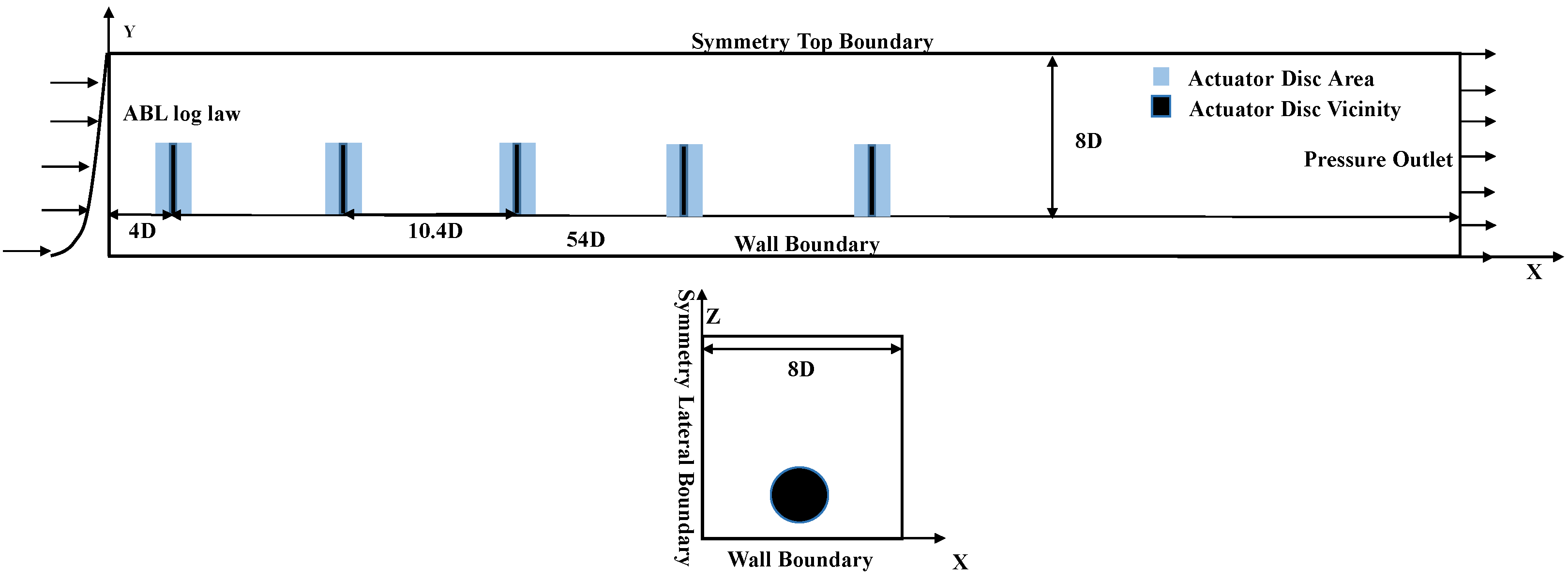

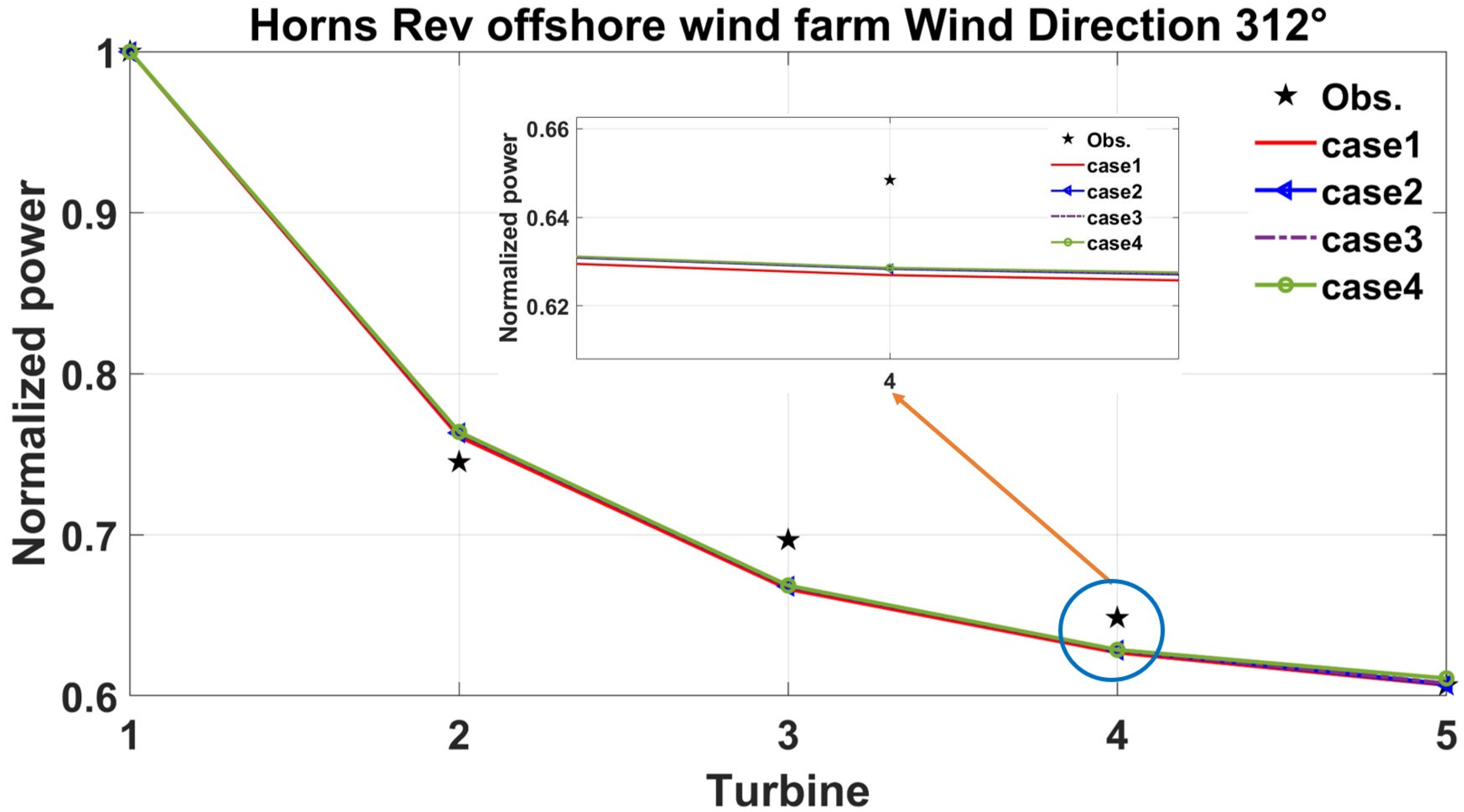
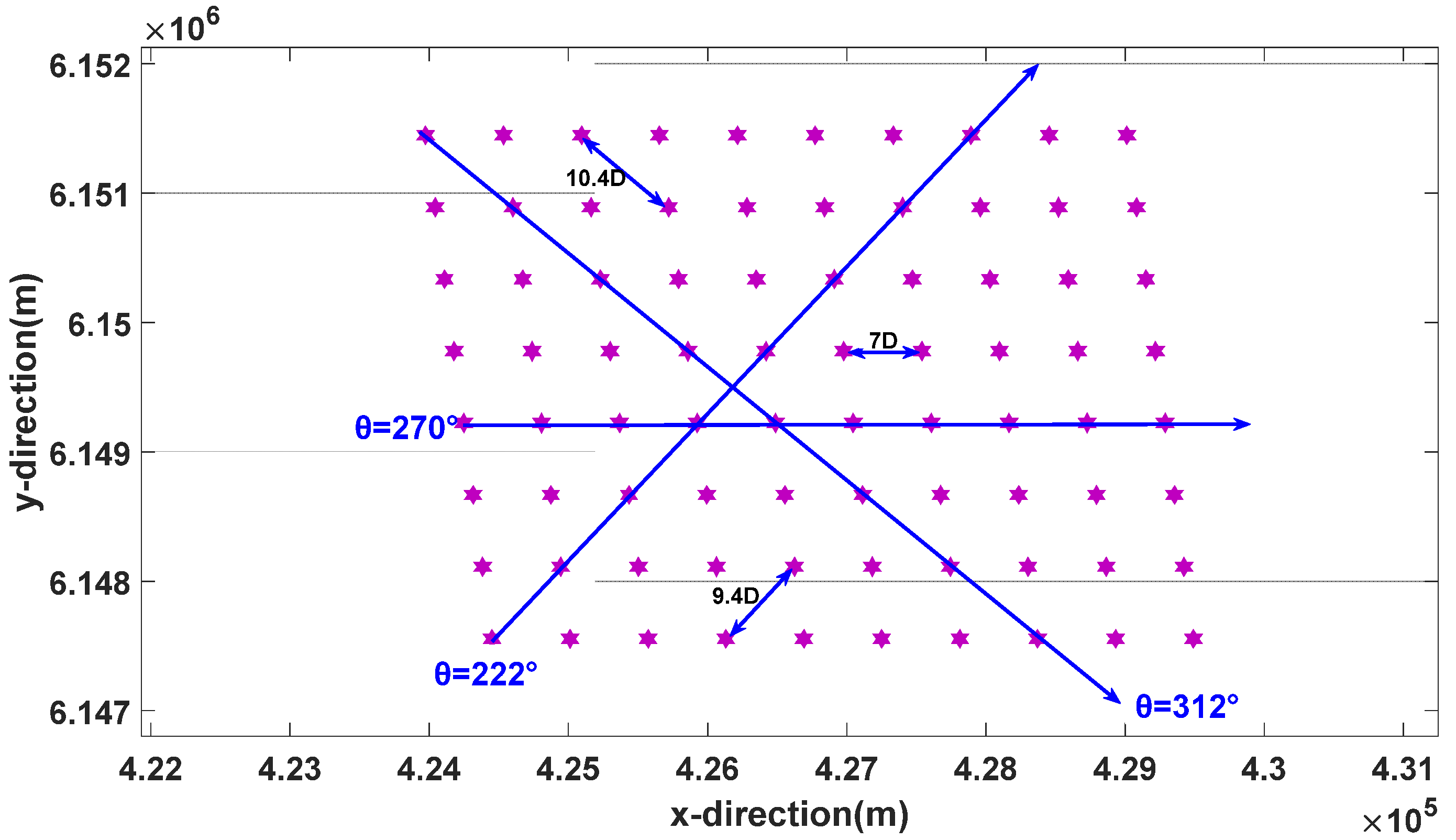
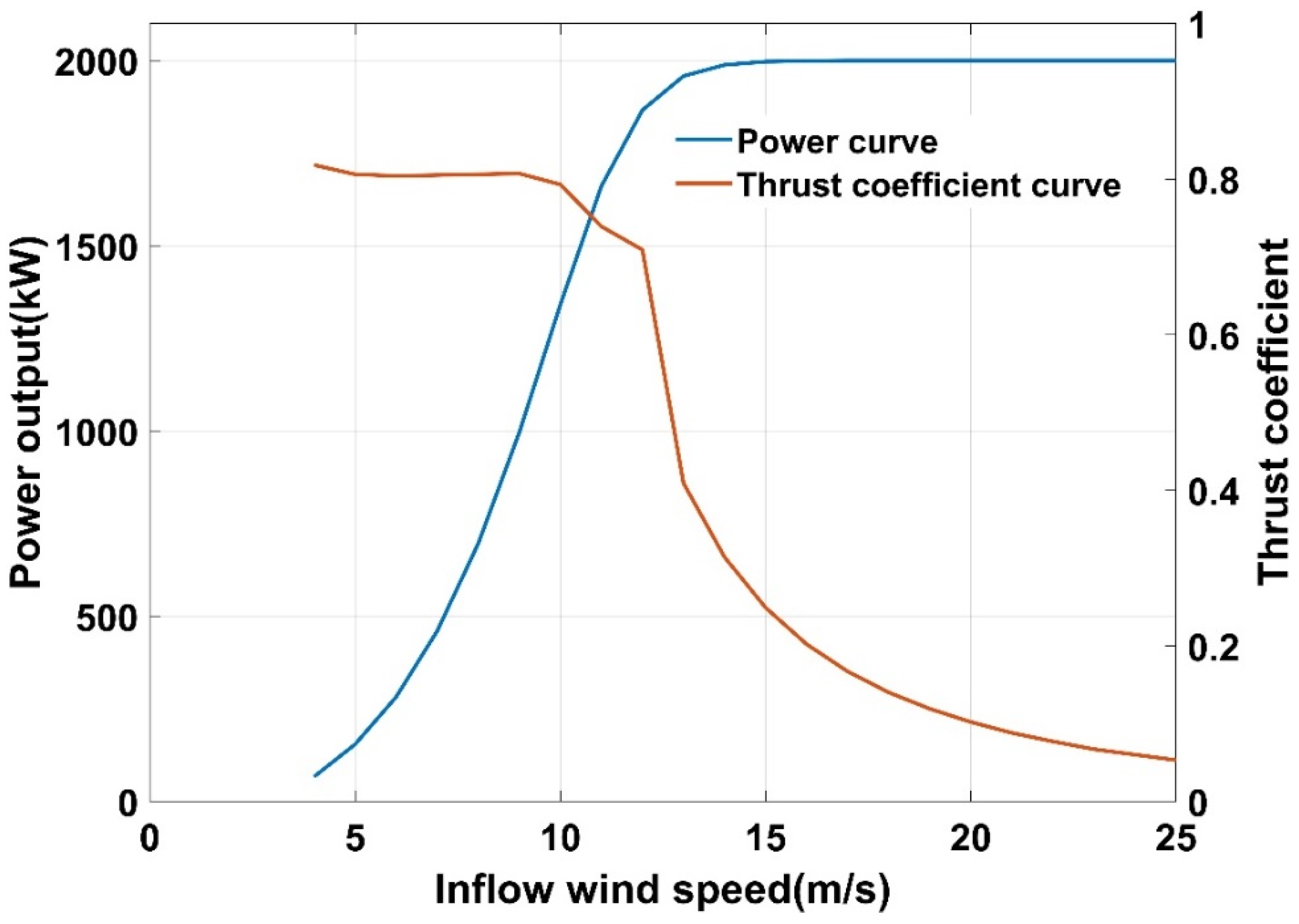
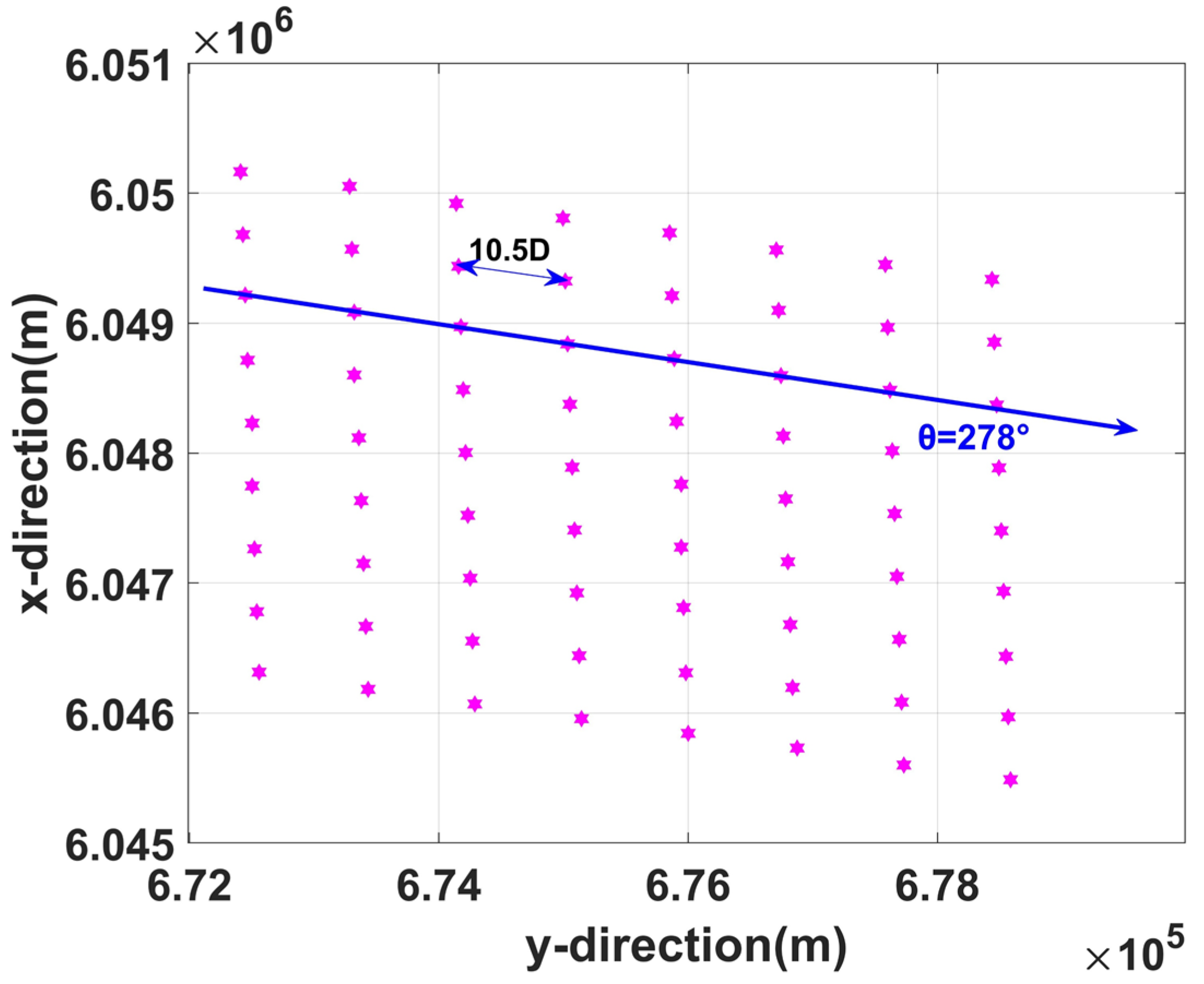
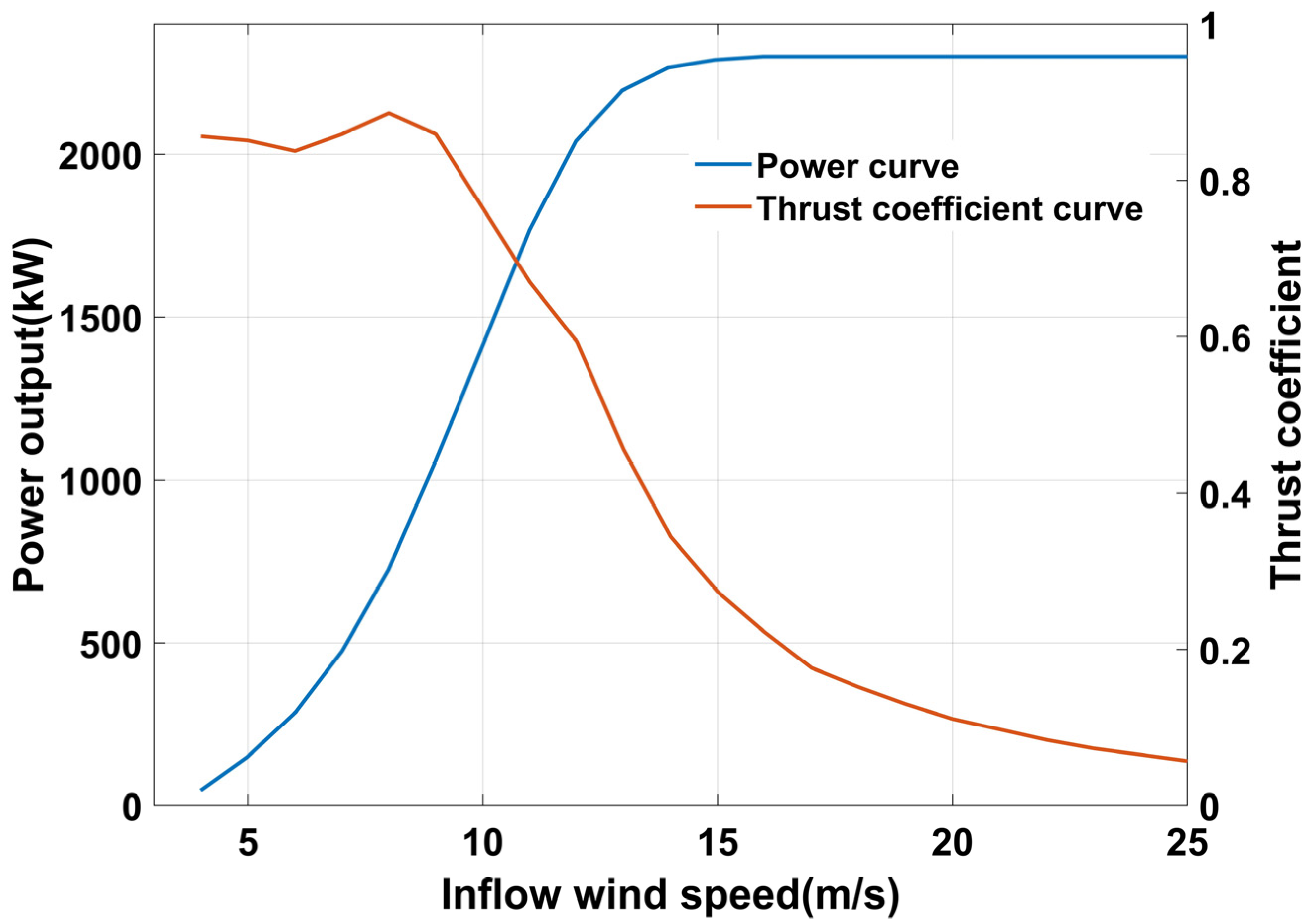

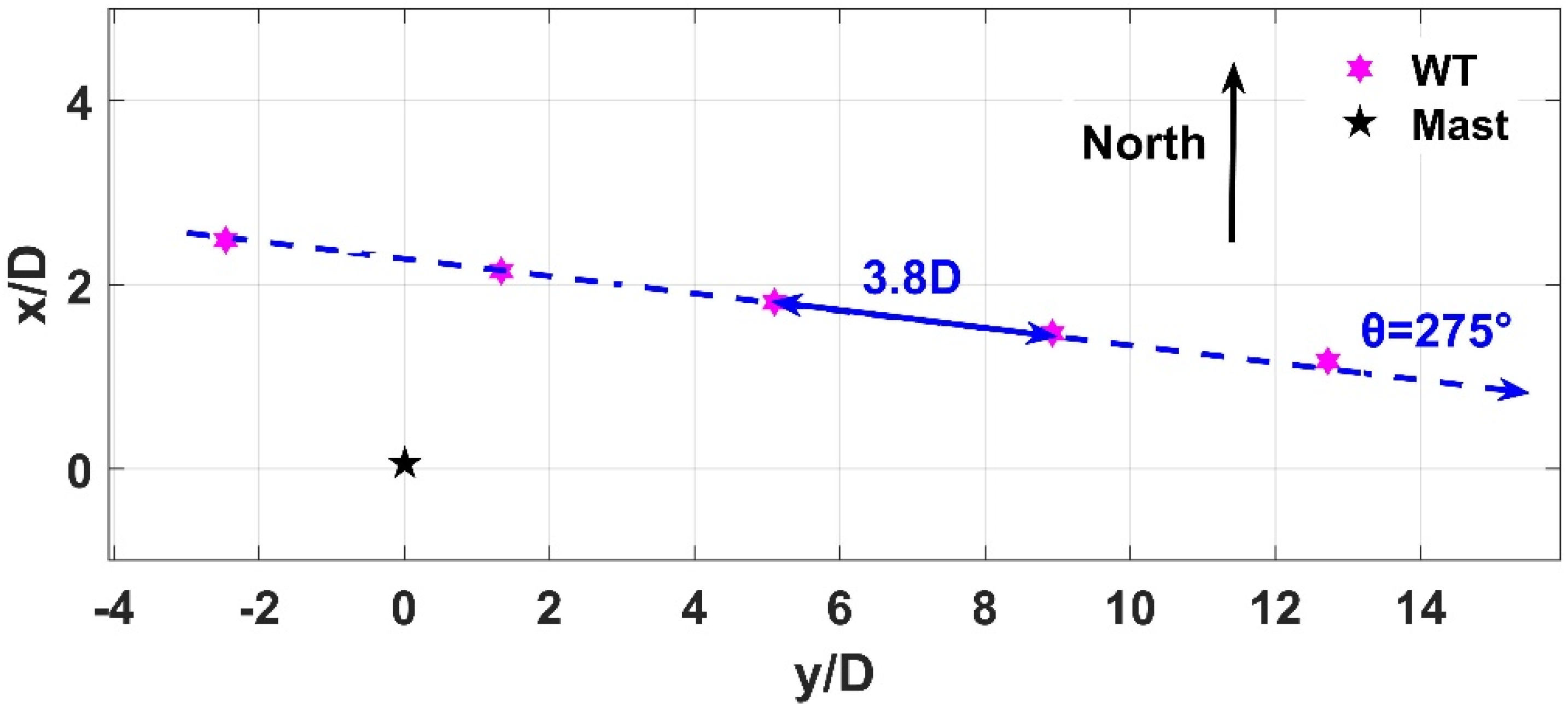
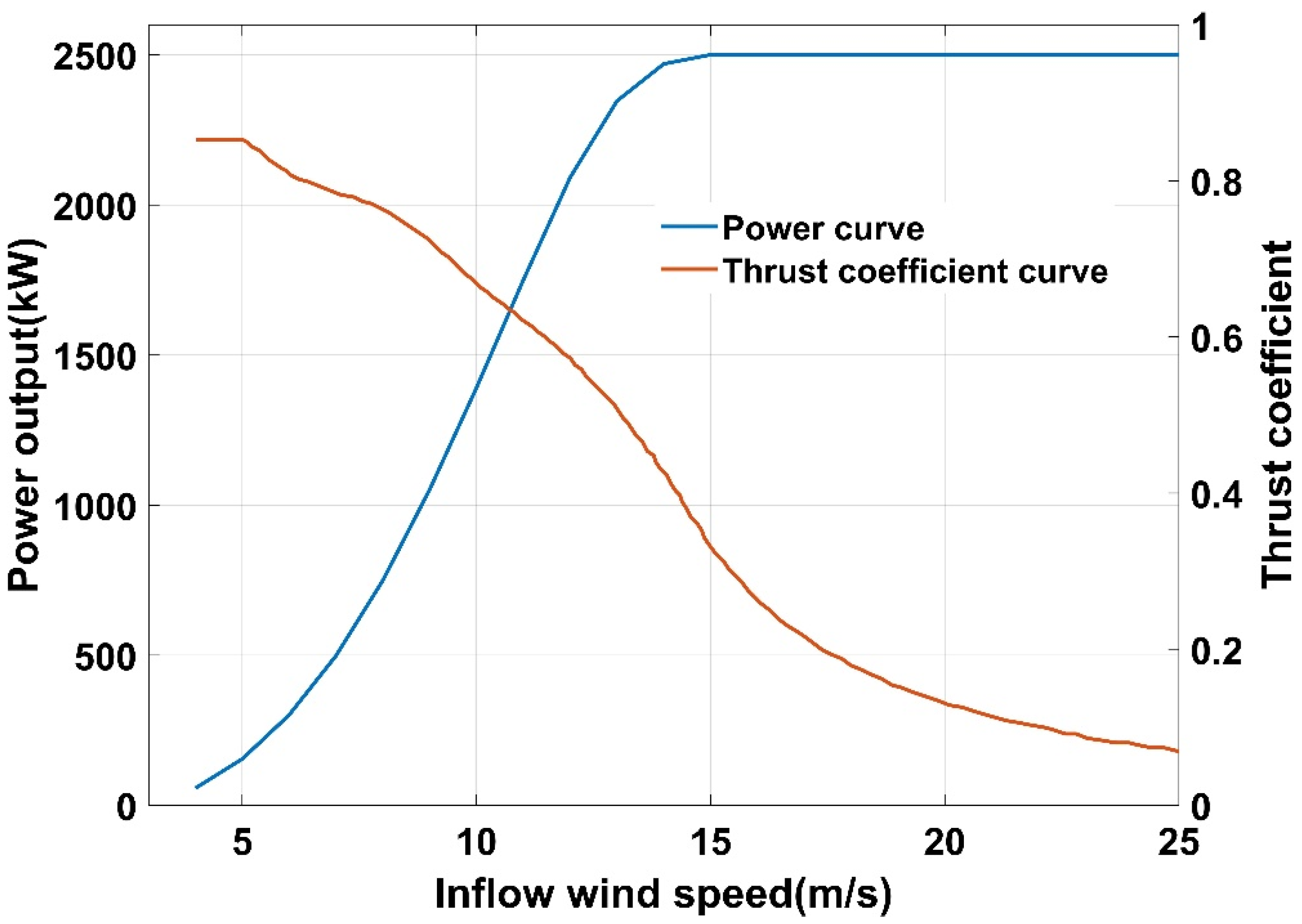
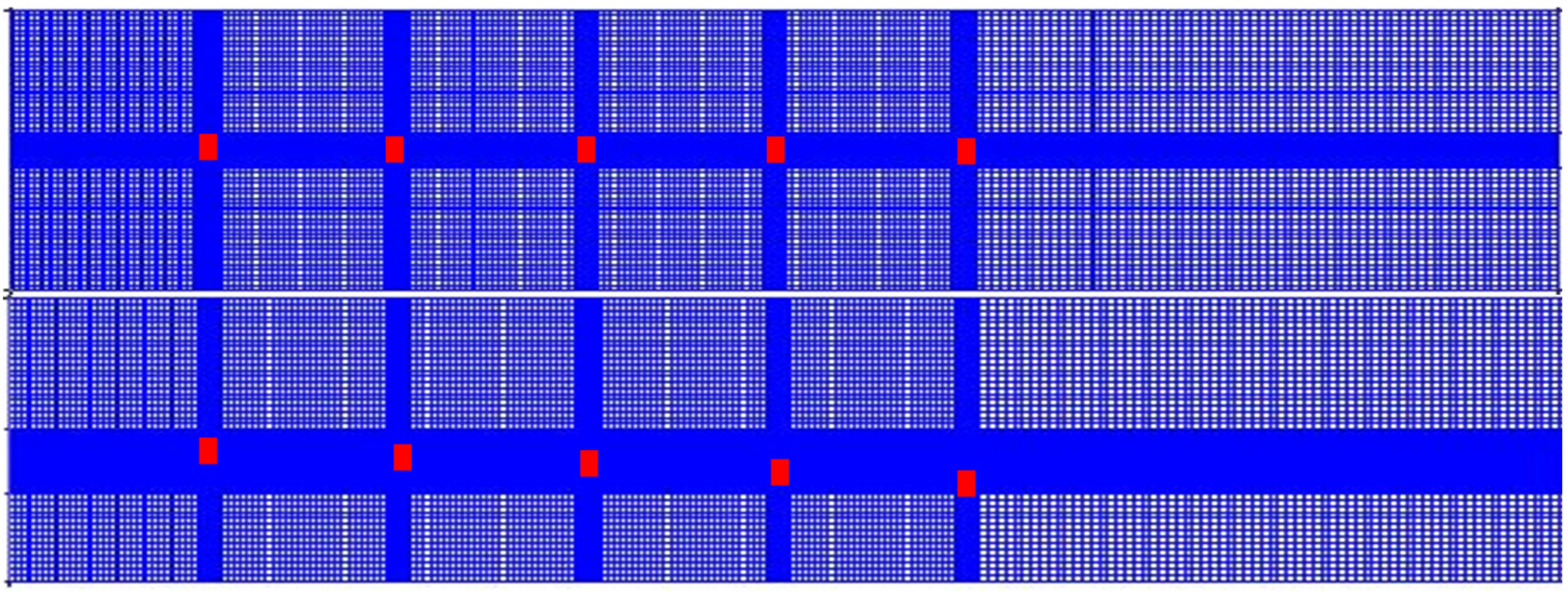


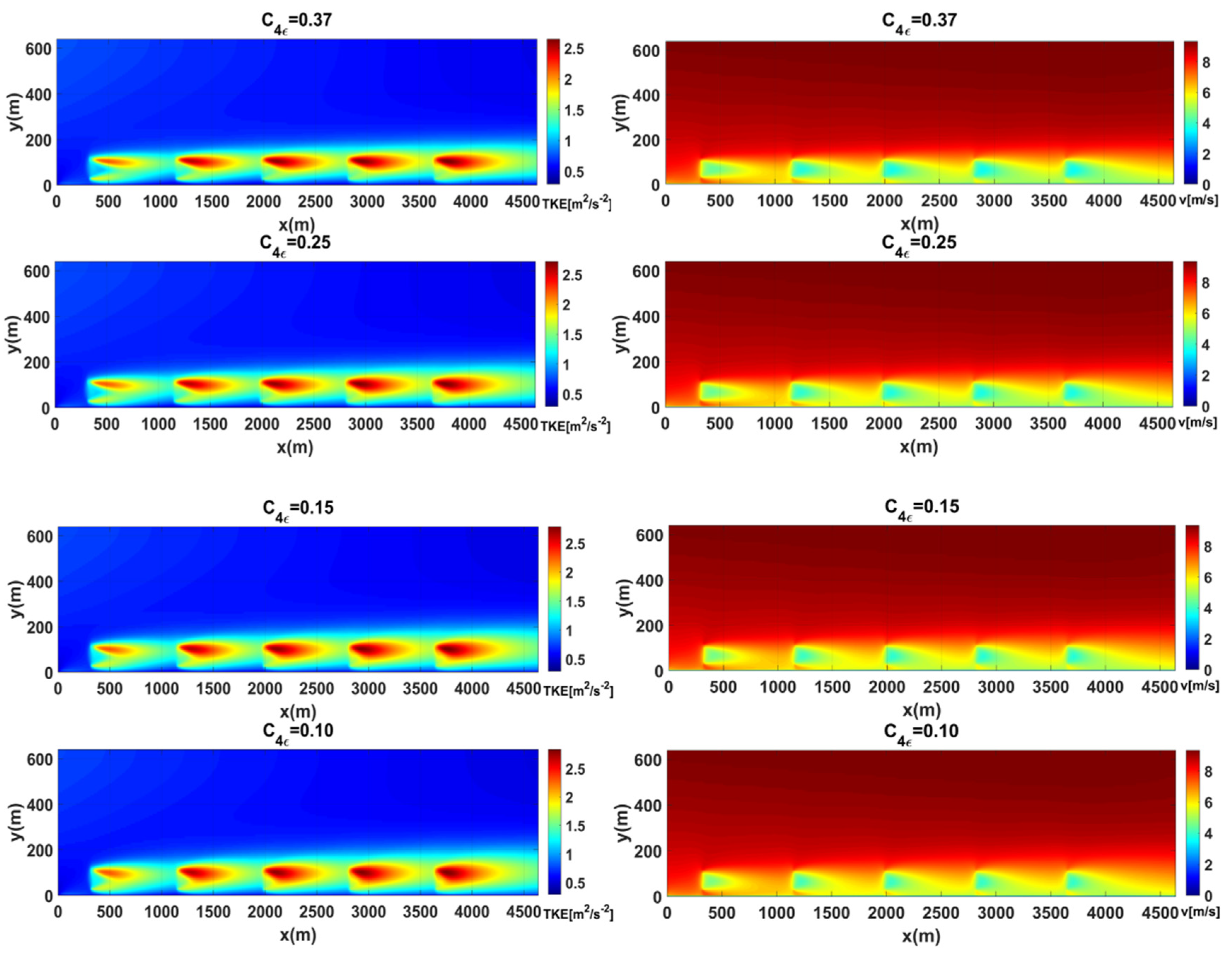
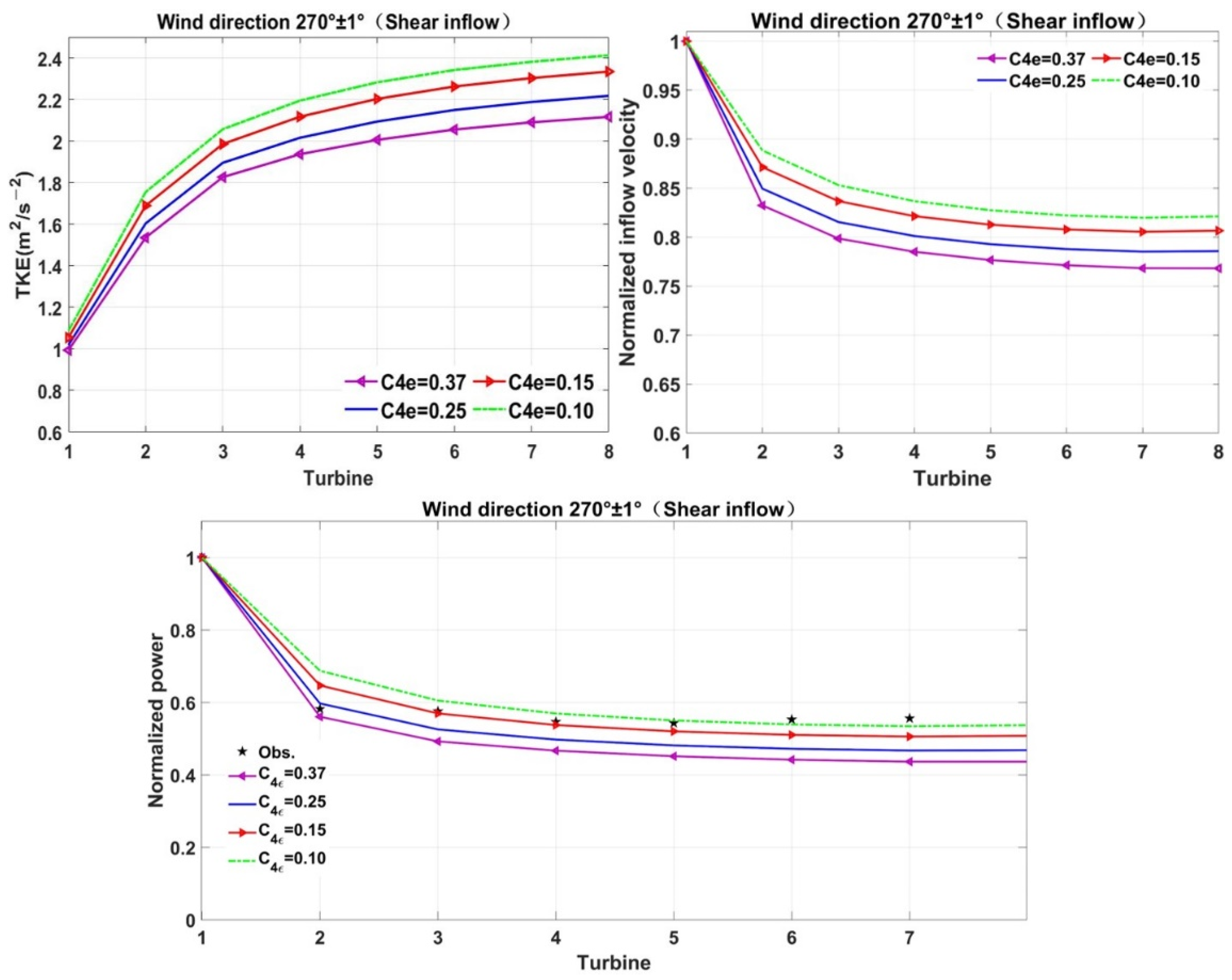
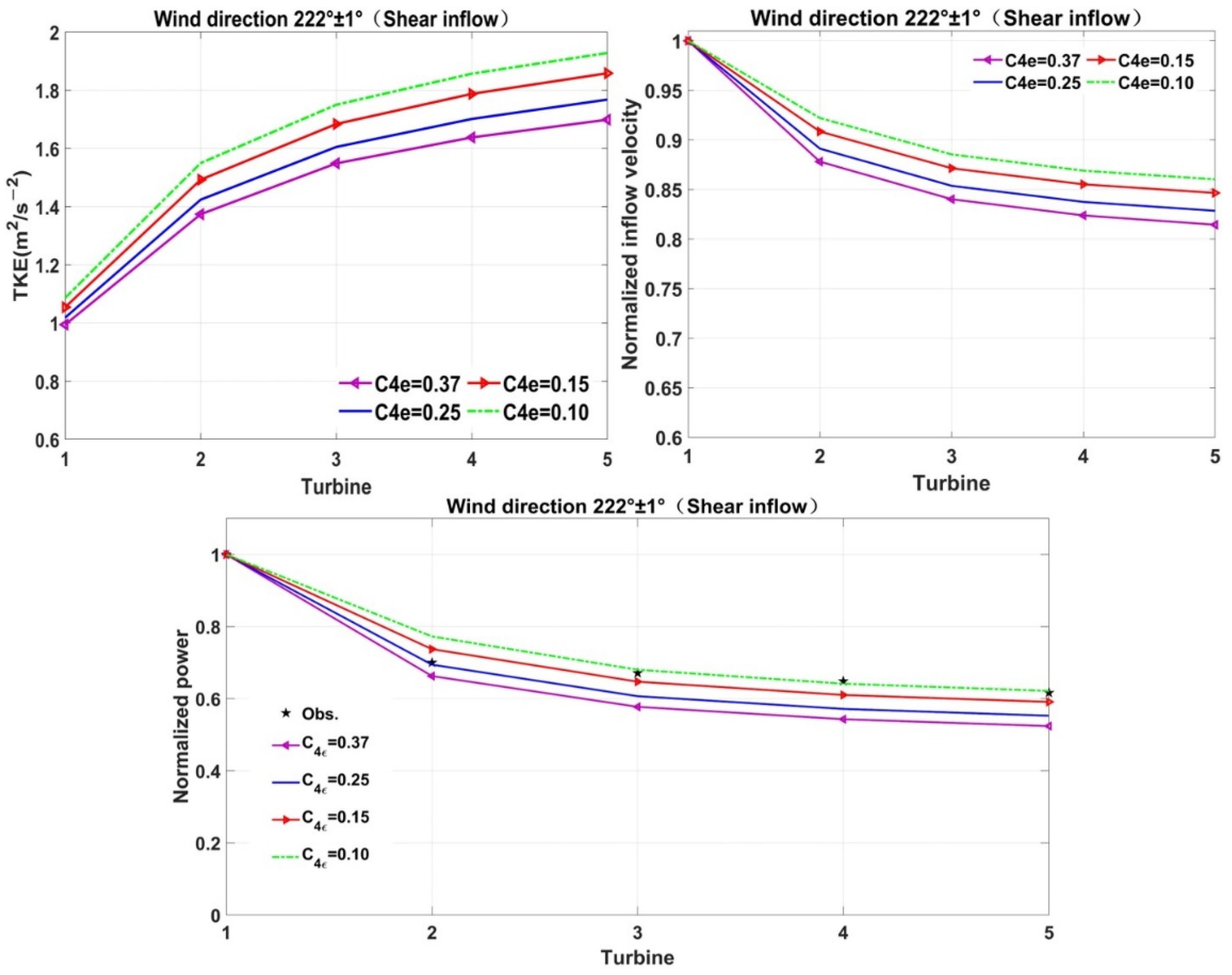
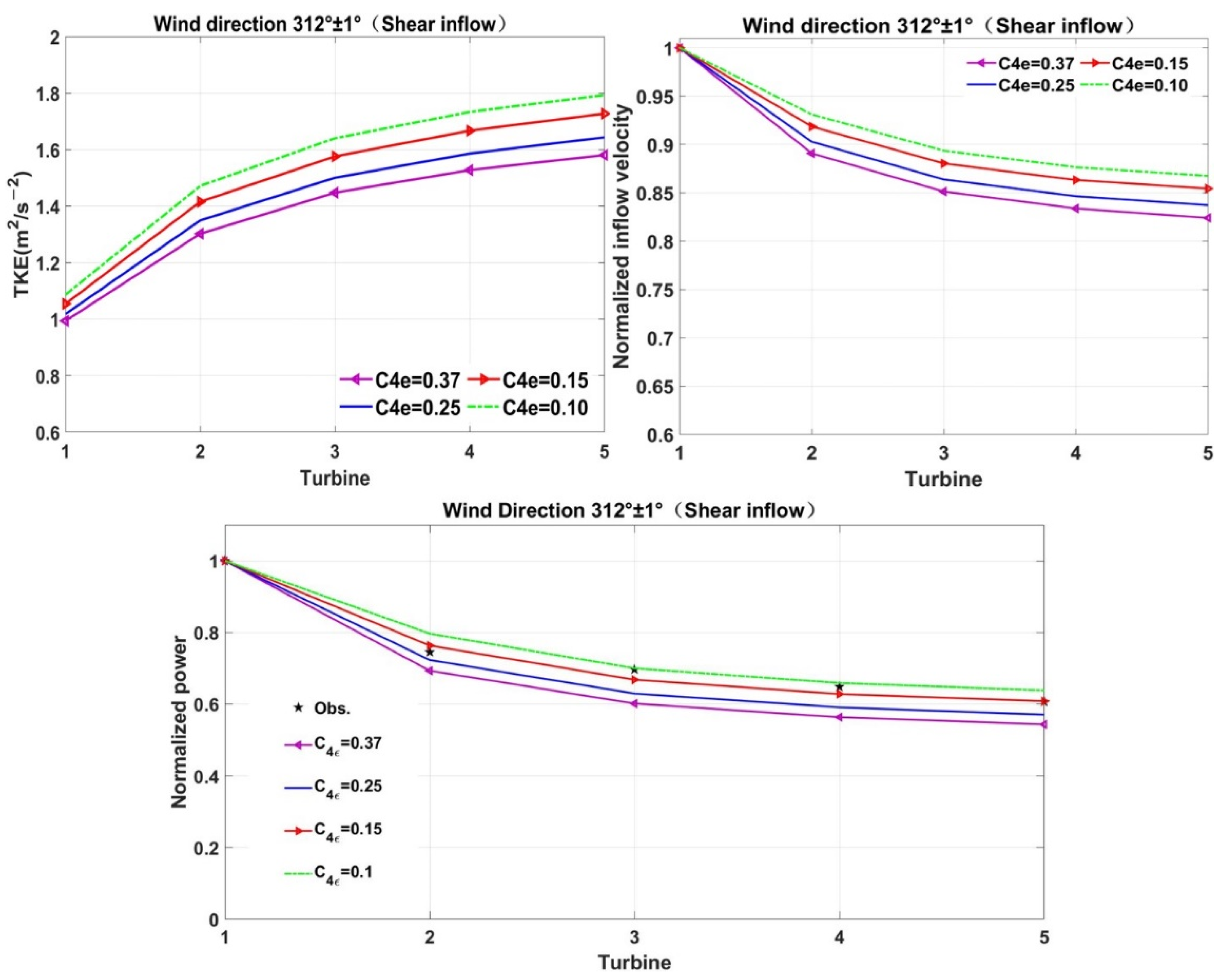
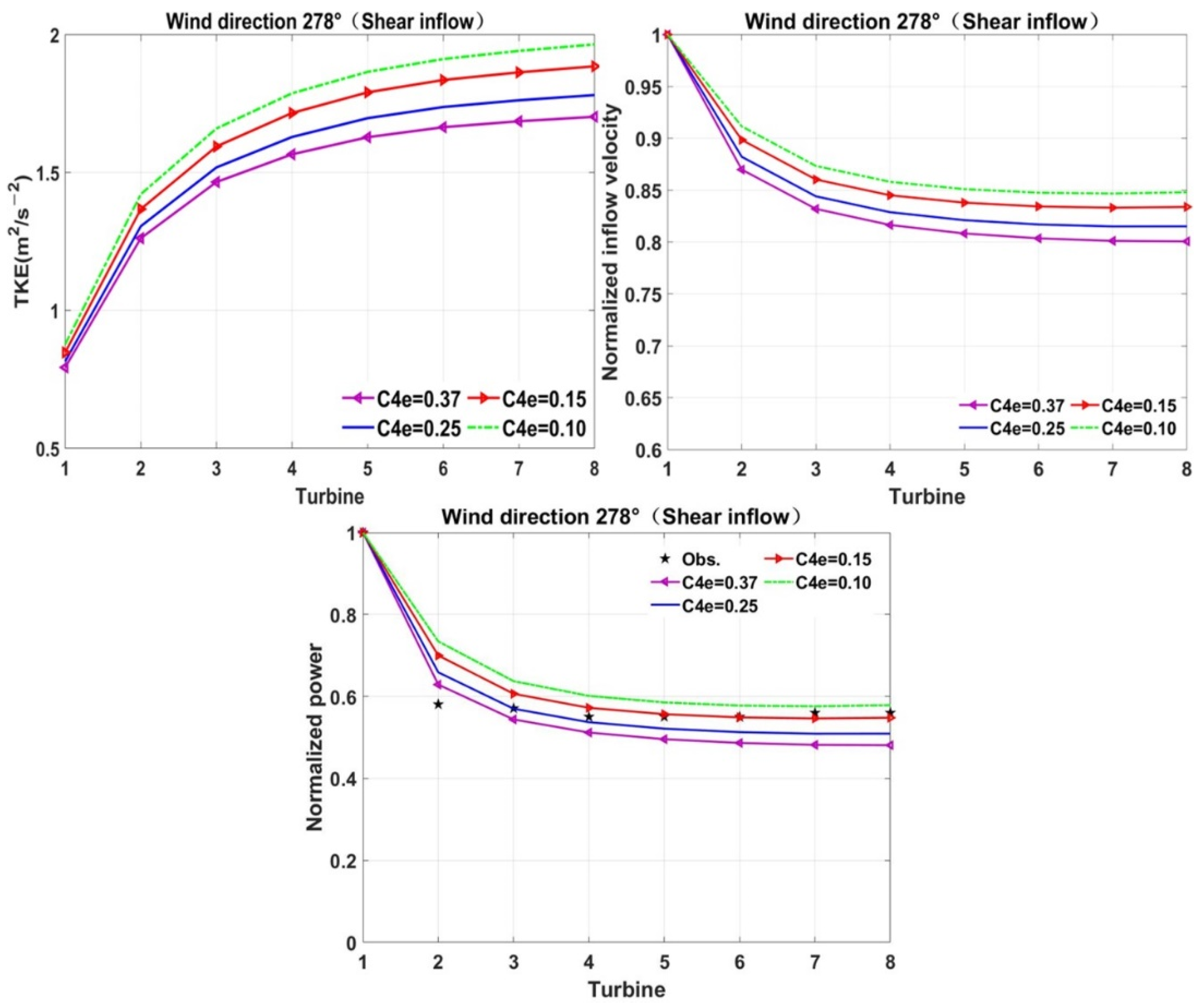


| Approach Description | Analytical Wind Farm Model | LES + ADM | RANS + ADM |
|---|---|---|---|
| Brief introduction | Simple physical principles combined with experiments or high-fidelity CFD data | Directly resolving the large-scale turbulence well, and effects of the small-scale turbulence on large-scale turbulence solved by the filter eddy viscosity model | Using the filter approach of time-average to model turbulent flow based on the isotropic hypothesis |
| Accuracy | Not always guaranteed | High | Between the two methods mention above, but close to LES + ADM |
| Computational cost (the case of five inline WTs) | Very fast | Approximately 1000-fold higher than RANS simulations | 2 h, two E5 2690 with 28 cores |
| Scope of engineering applications | Micro-sitting, layout optimization, power assessment and operation control | Great challenges to engineering applications | Micro-sitting optimization and power assessment |
| References | [3,6,7,8,9] | [1,5,10,11,12] | [13,14,15,16,17] |
| σk | σε | Cμ | C1ε | C2ε | C4ε |
|---|---|---|---|---|---|
| 1.0 | 1.3 | 0.033 | 1.176 | 1.92 | 0.37 |
| Case Setting | Flow Domain Cells/Per Rotor Diameter | Total Number of Grid Points |
|---|---|---|
| Case 1 | 4 | 1,677,546 |
| Case 2 | 6 | 2,414,160 |
| Case 3 | 10 | 3,897,894 |
| Case 4 | 16 | 5,687,682 |
| Case 5 | 32 | 10,540,530 |
| Case | Description | Measured Data | UH,ꝏ [m/s] | IH,ꝏ [%] | D [m] | z0 [m] | Spacing [m/D] |
|---|---|---|---|---|---|---|---|
| Offshore wind farm | |||||||
| 1 | Horns Rev | wd = 270 ± 1° | 8 | 7.7 | 80 | 0.0002 | 7 |
| 2 | Horns Rev | wd = 222 ± 1° | 8 | 7.7 | 80 | 0.0002 | 9.4 |
| 3 | Horns Rev | wd = 312 ± 1° | 8 | 7.7 | 80 | 0.0002 | 10.4 |
| 4 | Nysted | wd = 278° | 8 | 6.3 | 82.4 | 0.0002 | 10.5 |
| 5 | Nysted | wd = 278° | 10 | 6.3 | 82.4 | 0.0002 | 10.5 |
| Onshore wind farm | |||||||
| 6 | Wieringermeer | wd = 275 ± 3° | 6.59 | 2.4 | 80 | 0.05 | 3.8 |
| Case | Description | C4ε | UH,ꝏ [m/s] | IH,ꝏ [%] | D [m] | z0 [m] | Spacing [m/D] |
|---|---|---|---|---|---|---|---|
| 1 | Horns Rev (wd = 270 ± 1°) | 0.37, 0.25, 0.15, 0.10 | 8 | 7.7 | 80 | 0.0002 | 7 |
| 2 | Horns Rev (wd = 222 ± 1°) | 0.37, 0.25, 0.15, 0.10 | 8 | 7.7 | 80 | 0.0002 | 9.4 |
| 3 | Horns Rev (wd = 312 ± 1°) | 0.37, 0.25, 0.15, 0.10 | 8 | 7.7 | 80 | 0.0002 | 10.4 |
| 4 | Nysted (wd = 278°) | 0.37, 0.25, 0.15, 0.10 | 8 | 6.3 | 82.4 | 0.0002 | 10.5 |
| 5 | Nysted (wd = 278°) | 0.37, 0.25, 0.15, 0.10 | 10 | 6.3 | 82.4 | 0.0002 | 10.5 |
| 6 | Wieringermeer(wd = 275 ± 3°) | 0.37, 0.25, 0.15, 0.10 | 6.59 | 2.4 | 80 | 0.05 | 3.8 |
| Case 1 | ||||
| 14.35 | 10.04 | 5.74 | 5.16 | |
| 9.16 | 6.54 | 3.58 | 4.25 | |
| Case 2 | ||||
| 10.11 | 6.51 | 3.77 | 2.73 | |
| 7.72 | 5.31 | 2.85 | 3.29 | |
| Case 3 | ||||
| 8.81 | 5.45 | 1.99 | 2.86 | |
| 7.88 | 5.40 | 2.73 | 3.43 | |
| Case 4 | ||||
| 8.69 | 5.77 | 4.59 | 8.11 | |
| 5.47 | 4.13 | 4.52 | 6.44 | |
| Case 5 | ||||
| 7.37 | 5.77 | 4.06 | 8.53 | |
| 4.86 | 3.41 | 4.18 | 6.36 | |
| Case 6 | ||||
| 15.37 | 12.70 | 10.27 | 16.89 | |
| 5.83 | 3.91 | 3.51 | 5.34 | |
| Average Error | ||||
| 10.78 | 7.71 | 5.07 | 7.38 | |
| 6.82 | 4.78 | 3.56 | 4.85 |
Publisher’s Note: MDPI stays neutral with regard to jurisdictional claims in published maps and institutional affiliations. |
© 2022 by the authors. Licensee MDPI, Basel, Switzerland. This article is an open access article distributed under the terms and conditions of the Creative Commons Attribution (CC BY) license (https://creativecommons.org/licenses/by/4.0/).
Share and Cite
Li, N.; Li, L.; Liu, Y.; Wu, Y.; Meng, H.; Yan, J.; Han, S. Effects of the Parameter C4ε in the Extended k-ε Turbulence Model for Wind Farm Wake Simulation Using an Actuator Disc. J. Mar. Sci. Eng. 2022, 10, 544. https://doi.org/10.3390/jmse10040544
Li N, Li L, Liu Y, Wu Y, Meng H, Yan J, Han S. Effects of the Parameter C4ε in the Extended k-ε Turbulence Model for Wind Farm Wake Simulation Using an Actuator Disc. Journal of Marine Science and Engineering. 2022; 10(4):544. https://doi.org/10.3390/jmse10040544
Chicago/Turabian StyleLi, Ning, Li Li, Yongqian Liu, Yulu Wu, Hang Meng, Jie Yan, and Shuang Han. 2022. "Effects of the Parameter C4ε in the Extended k-ε Turbulence Model for Wind Farm Wake Simulation Using an Actuator Disc" Journal of Marine Science and Engineering 10, no. 4: 544. https://doi.org/10.3390/jmse10040544
APA StyleLi, N., Li, L., Liu, Y., Wu, Y., Meng, H., Yan, J., & Han, S. (2022). Effects of the Parameter C4ε in the Extended k-ε Turbulence Model for Wind Farm Wake Simulation Using an Actuator Disc. Journal of Marine Science and Engineering, 10(4), 544. https://doi.org/10.3390/jmse10040544







